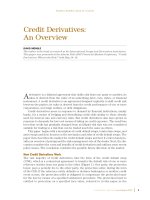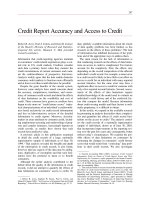Credit Scores, Credit Cards pptx
Bạn đang xem bản rút gọn của tài liệu. Xem và tải ngay bản đầy đủ của tài liệu tại đây (582.92 KB, 289 trang )
SILVER LAKE PUBLISHING
LOS ANGELES, CA ABERDEEN, WA
Credit
Scores,
Credit
Cards
How Consumer Finance Works:
How to Avoid Mistakes and
How to Manage Your Accounts Well
Credit Scores, Credit Cards
How Consumer Finance Works: How to
Avoid Mistakes and How to Manage Your
Accounts Well
First edition, 2005
Copyright © 2005 by Silver Lake Publish-
ing
Silver Lake Publishing
111 East Wishkah Street
Aberdeen, WA 98520
For a list of other publications or for more
information from Silver Lake Publishing,
please call 1.360.532.5758. Find our
Web site at www.silverlakepub.com.
All rights reserved. No part of this book
may be reproduced, stored in a retrieval
system or transcribed in any form or by
any means (electronic, mechanical, record-
ing or otherwise) without the prior writ-
ten permission of Silver Lake Publishing.
Library of Congress Catalogue Number:
Pending
The Silver Lake Editors
Credit Scores, Credit Cards
Includes index.
Pages: 288
ISBN: 1-56343-782-1
ACKNOWLEDGMENTS
The Silver Lake Editors who have contributed to
this book are Sander Alvarez, Esq., Sue Elliot-Sink,
Kristin Loberg and James Walsh.
This is the 16
th
title in Silver Lake Publishing’s se-
ries of books dealing with risk and economic issues
that face people living in the United States and other
developed countries.
In this book, we refer to contract terms and legal
decisions from the United States—but the spirit of
the discussion about consumer credit can apply be-
yond the jurisdiction of the courts cited.
The discussions of standard practices, contracts,
laws and court cases in this book are intended only
to illustrate underlying terms and concepts. Noth-
ing in this book should be interpreted as giving
specific legal, financial or other advice. Legal stan-
dards and best practices are constantly changing.
Check with a certified credit counselor, certified tax
adviser or attorney before taking any action based
on what you read in this book.
This book is intended to make the theories and prac-
tices of consumer lending understandable. The Sil-
ver Lake Editors welcome feedback. Please call us at
1.360.532.5758 during regular business hours,
Pacific time. Fax us at 1.360.532.5728. Or e-mail
us at
James Walsh, Publisher
ACKNOWLEDGMENTS
CONTENTS
CHAPTER 1
Why Credit Is So Important 7
CHAPTER 2
The Mechanics of Credit Scores 21
CHAPTER 3
How Credit Cards Work 43
CHAPTER 4
Choosing a Credit Card 59
CHAPTER 5
Using a Credit Card Wisely 85
CHAPTER 6
Dealing with Credit Bureaus 101
CHAPTER 7
Who Can Look at Your Credit 115
CHAPTER 8
Red Flags and Black Marks 127
CHAPTER 9
If You’re Having
Money Problems
153
TABLE OF CONTENTS
CHAPTER 10
Family Issues 187
CHAPTER 11
Improving Your Credit Score 207
CHAPTER 12
Mortgages and Car Loans 227
CHAPTER 13
Keeping Good Credit 251
CHAPTER 14
Key Credit Terms 267
INDEX 283
CHAPTER 1: WHY CREDIT IS SO IMPORTANT
7
CHAPTER
WHY CREDIT IS
SO IMPORTANT
You’ve found your dream house. The neighborhood
is perfect. The schools are great. The kitchen has
everything you want.
You’ve negotiated a good price. You’ve signed reams
of paperwork. And you open an escrow account.
Then your mortgage broker calls. Remember the
great interest rate she quoted you last week? You
don’t qualify for it. She says there are some prob-
lems with your FICO score. Your interest rate is go-
ing to be higher by almost four percentage points.
Suddenly, your monthly payments on a $200,000
loan jump from $1,150 to $1,620. That’s a 40 percent
increase!
Your eyes well up with tears as that dream house
slips away—along with the nonrefundable deposit
check you’d written. And it’s all because the mort-
gage lenders said your credit score was low.
1
8
CREDIT SCORES, CREDIT CARDS
Buying a house is the single biggest purchase most
consumers will ever make—and the vast majority
of people buy that house on credit. But home buy-
ing isn’t the only time your credit is important.
Your credit is a factor when you want to rent an
apartment, buy a car, get braces for your children
or take advantage of a “no interest for six months”
offer on a big-screen TV. Sometimes, your credit
history will even come into play when you apply
for insurance or for a job.
Credit history plays a vital role in your day-to-day
life, making expenses like a home mortgage more—
or less—expensive for you. And it’s practically im-
possible to rent a car without a credit card.
IT’S A CREDIT ECONOMY
A growing number of people purchase products and
services on credit—either with credit cards or by
taking out other types of consumer loans. Ameri-
cans borrow to buy cars and trucks and put less
money down when they buy homes, as home prices
escalate in many parts of the country.
But credit cards are the fastest growing form of
consumer borrowing in the developed world. And
they have the biggest impact on most consumers’
financial status.
Credit cards are used on a regular basis by more
than 73 percent of American households, up from
16 percent in the 1970s. Most Americans have at
least one general-purpose credit card these days, and
CHAPTER 1: WHY CREDIT IS SO IMPORTANT
9
more often they have two or three. By general-pur-
pose, we mean a credit card not issued by a specific
store or retail chain; these cards include Visa,
MasterCard, Discover or American Express cards that
can be used almost anywhere.
In 1999, American consumers charged about $1.2
trillion on their general-purpose credit cards. By
2003, that number had grown by about a third—to
more than $1.5 trillion.
Specifically, American Express saw a 13 percent in-
crease in cardholder spending from 2003 to 2002.
And that business was increasingly profitable. Ac-
cording to the company, American Express Bank
(AEB) reported net income for 2003 of $102 mil-
lion, up 27 percent from $80 million the year prior.
Visa, the largest player in the general-purpose credit
card market, generated around $3 trillion in card
sales volume worldwide each year in the early
2000s. Even Diners Club, a relatively small player
in the market, racked up gross sales volume of $31
billion in 2001.
And then there are so-called “captive cards”—credit
cards issued by department stores, gas stations and
specialty retailers. They account for something like
half again the amount charged to the general-pur-
pose cousins.
In theory, credit cards allow you to enjoy your pur-
chases for as long as a month before you have to pay
10
CREDIT SCORES, CREDIT CARDS
a dime—and it’s all interest-free. Or at least it would
be interest-free, if people paid off their credit card
balances in full each month. Most don’t.
According to Fair, Isaac & Co., which tracks con-
sumers’ credit histories, about 10 percent of Ameri-
cans have credit card balances that exceed $10,000.
On the other hand, nearly half of the population is
much more conservative, carrying a balance of less
than $1,000. (You’ll read a lot about Fair, Isaac &
Co.—called by the acronym “FICO” by people in
the credit and banking industries—through the
course of this book.)
Those balances generate a lot interest—money owed
to the card companies by the card users. In some
cases, the interest rates are as high as 23 percent.
(However, the industry group Your Credit Card Com-
panies notes that the average credit card interest
rate was approximately 12.75 percent in 2003.)
Of course, credit cards aren’t the only kind of credit
consumers use. According to FICO, the average con-
sumer today has 11 credit “obligations.” Of those,
seven are likely to be credit cards; the other four are
likely to be installment loans—including auto,
home and student loans.
If you add it all up, you find that 30 percent of
Americans carry more than $10,000 of non-mort-
gage-related consumer debt. And credit cards are
the biggest slice of that debt pie.
CHAPTER 1: WHY CREDIT IS SO IMPORTANT
11
The good news: Most people pay their bills on time.
FICO notes that fewer than 40 percent of consum-
ers have ever been reported as 30 or more days late
on a payment, and only 20 percent have ever been
60 or more days past due.
CREDIT KEEPS GETTING EASIER
Consumer credit is a sort of self-fulfilling proph-
ecy. As more consumers use it, more merchants need
to accept it. And, as more merchants accept it, more
consumers use it.
That’s why it seems as if everybody wants to offer
you credit these days. If you shop at a department
store and you pay with cash or by check, many
employees have been trained to ask you to open
up one of the store’s own charge accounts.
Even relatively small businesses can offer a private-
label credit card to their customers. That’s because
credit card companies offer specialized programs
through a variety of trade associations.
For instance, members of SEMA (the Specialty
Equipment Market Association) are all eligible to
participate in CarCareONE, a private-label credit-
card program from GE Retail Sales Finance. So,
manufacturers, distributors, retailers and installers
can offer their customers instant, on-the-spot credit,
as well as 90-day “same-as-cash financing.”
12
CREDIT SCORES, CREDIT CARDS
Why do they? According to SEMA, “Many compa-
nies find that consumers with CarCareONE credit
cards will make larger purchases and are more
loyal than customers without the card.”
As the name suggests, CarCareONE credit cards are
automobile-focused. But private-label programs ex-
tend far beyond the automotive world. Citi Com-
merce Services (CCS) helps all kinds of businesses
develop customized retail credit card program. In
fact, CCS has made it possible for retailers in a wide
range of industries to offer a store-specific credit
card. These industries include:
• travel;
• jewelry;
• apparel;
• catalog sales;
• furniture;
• automotive;
• office products;
• home improvement;
• consumer electronics; and
• computers.
These are the credit programs for merchants. On
the consumer side, credit card companies market
their products even more aggressively. The best
example of this: So-called “affinity” cards. These
are general-purpose credit cards that are associated
with a particular airline or auto maker or member-
ship group. These cards—usually Visa or
CHAPTER 1: WHY CREDIT IS SO IMPORTANT
13
MasterCard, but with that fact downplayed—gen-
erate benefits based on how many dollars the holder
spends. The benefits are specific to the group; such
as frequent flier miles with an airline card, contri-
butions with a political affinity card or discounts
on car purchases with an auto maker card.
There are the affinity cards that you can sign up for
in order to get zero interest for several months on a
major purchase—such as the Visa cards offered by
Circuit City and other consumer electronics retailers
in order to get you to spring for that $3,000 home
entertainment system.
There are traps and fine-print conditions to all of
these benefits, as we’ll see later. But the fact remains
that credit cards are a booming part of the economy.
A CREEPING EFFECT
Credit has a steady, cumulative effect on the way
people buy things. The car industry is a good ex-
ample of this creeping influence.
Through the 1960s, most Americans paid cash for
their automobiles. If a person borrowed to buy a
car, he or she would usually make a large down-
payment (often half the purchase price) and take a
one- or two-year secured loan through a local bank.
In the 1970s, auto makers decided to finance the
purchase of their products in a systematic way. They
14
CREDIT SCORES, CREDIT CARDS
marketed two- and three-year loans which required
smaller down payments.
In the 1980s, car companies started leasing cars—
which essentially eliminated the down payment
and the whole idea of a car as a thing that someone
would buy and keep for many years. It also made
luxury cars more affordable to most consumers. At
first, leases had two- to three-year terms. Traditional
loans lengthened their standard terms to four or
five years to compete.
By the early 2000s, most Americans financed most
of their new car purchases. Gone were the days of
24-month auto loans; five-year loans or leases had
become standard—and six-year loans were increas-
ingly common.
So-called “luxury” vehicles—which included some
trucks—had grown from less than 10 percent of
the car market to more than 30 percent.
This is the cumulative effect of consumer debt: Higher
prices and levels of luxury and less outright owner-
ship. Some consumer advocates criticize this pro-
cess as making a permanent debtor class; but oth-
ers defend it as bringing the life-style of the wealthy
to a mass market.
Whatever the sociological concerns, there’s no doubt
that a credit economy requires an ordinary citizen
to pay more attention to his or her ability to get
credit.
CHAPTER 1: WHY CREDIT IS SO IMPORTANT
15
STUDENT LOAN DEBT
Like the automobile industry, the university edu-
cation industry has used credit to create new cus-
tomers and sell them more expensive product.
With university tuition costs rising faster than other
prices, many students are encouraged to borrow
money through any of several government-spon-
sored loan programs. As a result, they graduate
with incredible debt loads.
For example, in 2004, the annual tuition at the
University of California, Los Angeles (UCLA) was
$6,585.52 for a California resident and $23,541.52
for a nonresident. That didn’t take into account hous-
ing, books, meals or any other living expenses.
According to the University of Notre Dame, the
average 2004-05 expense budget for an under-
graduate student included:
Tuition and Fees $29,510
Room and Board 7,590
Books and Supplies 850
Personal Expenses 900
Transportation 500
Total $39,350
16
CREDIT SCORES, CREDIT CARDS
According to the American Council on Education:
More students are borrowing to pay for their col-
lege education, up from 49 percent in 1993 to
65 percent in 2000. Students also borrowed more.
In 1992-93, the median amount borrowed was
just over $9,500. In 1999-2000, that amount
jumped to $16,500.
While the Council’s studies showed that most stu-
dents who graduated in the class of 2000 have a
debt burden equal to seven percent of their income,
the Council warned, “Debt burden is a growing
concern for a subset of students with larger than
average debt or lower than average earnings.”
Furthermore, “Debt burden will increase if borrow-
ing levels continue to rise, interest rates climb or
recent graduate salaries decline.”
INCREASING MORTGAGE DEBT
While all consumer credit-based spending has been
rising, the jump in home mortgage debt worries
economists most.
From 2001 to 2004, home mortgage debt increased
25 percent (after adjusting for inflation), according
to the Senate’s Joint Economic Committee (JEC).
The JEC noted:
Analysts have expressed concern about the growth
of consumer debt and its effect on the U.S. economy.
CHAPTER 1: WHY CREDIT IS SO IMPORTANT
17
Some fear that the combination of increasing debt
and higher interest rates will impair the ability
of households to meet their monthly financial ob-
ligations. However, interest payments as a per-
centage of disposable income have actually fallen
since the end of the recession in 2001. Total house-
hold debt has increased since the end of the reces-
sion, but the vast majority of the increase can be
attributed to the growth of home mortgage debt
spurred by historically low mortgage interest rates.
Mortgage debt has grown from 32 percent of
gross domestic product (GDP) in 1980 to over
60 percent today. This increase is reflected in part
in the record-high home ownership rate in the U.S.
Consumer credit [including credit cards and auto
loans] grew more slowly, increasing from 13 per-
cent of GDP in 1980 to 18 percent.
THE BOTTOM LINE
Heavy consumer borrowing is a reality for many
Americans. So, it’s more important than ever for
every consumer to be smart about his or her credit
habits and ability to borrow. And the main way
that lenders measure this ability: credit scores.
Credit scores are the results of programs that lend-
ers use, based on information that other lenders
report to central information clearinghouses, to make
decisions about how you’re likely to pay.
18
CREDIT SCORES, CREDIT CARDS
Credit scoring systems award people points for hav-
ing credit, using it and making payments on time.
The more points you have, the better your credit.
Every time you use a credit card and pay the bal-
ance on time, your score goes up; every time you
go over your credit limit and pay late, your score
goes down.
Other financial or legal factors also are counted. Hav-
ing over $100,000 in cash in the bank raises your
score; declaring bankruptcy lowers it. A lot.
In the U.S., most lenders use some version of the
scoring system developed by Fair, Isaac & Co. A
person’s “FICO score” ranges from 400 to over 800
points. The range works something like this:
• A score of 420 means you can’t get a
credit card, car loan or home mortgage.
• A score of 570 means you can get any
of these—but you won’t get the best,
advertised interest rate. And you’ll
probably have to pay extra fees.
• A score of 720 means you’ll get the best
interest rates and the fewest fees.
Credit scores are fluid things. They can change as
quickly as monthly…though they usually change
on a quarterly basis.
Smaller changes usually occur more slowly; bigger
changes—if you declare bankruptcy or win the lot-
tery—occur more quickly.
CHAPTER 1: WHY CREDIT IS SO IMPORTANT
19
Your credit score is probably the most important
aspect of your life that isn’t managed by the gov-
ernment. It’s controlled by a loose affiliation of
banks, credit card companies, other kinds of lend-
ers and the credit bureaus that track all of the infor-
mation.
If you’re like most Americans, you have only a vague
idea of where you stand, in terms of your credit
score. Many people pay closer attention to their
mortgage interest rates or the deal they got on their
car. There’s something unpleasant about checking
the details of your credit score—even if, in truth,
it’s not so bad.
Likewise, many Americans are conditioned to look
at certain aspects of a credit deal but ignore oth-
ers. Did you sign up for a special low-interest pro-
motional card offer without reading any of the fine
print? In some cases, any purchases beyond the ini-
tial promotional offer may incur shockingly high
interest rates.
Electronics stores often play a variation on that
scheme. They will offer a captive card with a low
interest rate—sometimes a zero-interest rate. But the
special deal is only good for the
first purchase
on
the card. Everything else comes with a rate of 17 or
20 percent.
20
CREDIT SCORES, CREDIT CARDS
Do you know what will happen if you miss a pay-
ment or two on any of your credit cards? What about
your auto loans? Home loans? In many cases, the
interest rates will shoot up.
CONCLUSION
We’re not trying to give you guilt. We’re simply
pointing out the places where you may be able to
save substantial money, simply by paying atten-
tion to a few “little details.”
One way you can save serious money is by improv-
ing your credit score, since it’s directly related to
how much you pay for credit. For instance, people
with great credit scores (above 700) can pay tens of
thousands of dollars less, over the life of a 30-year
mortgage, than people with just okay credit scores.
And they can be related to other seemingly unre-
lated things, too, like your ability to get a job or
even get insurance. That’s right. Insurance compa-
nies and even potential employers may check out
your credit history to try and determine your level
of personal stability.
Whether you have good credit or lousy credit, the
first step is to find out what your credit score is.
Then take the steps we recommend in this book to
improve that score. Your wallet will feel the differ-
ence. So will you.
CHAPTER 2: THE MECHANICS OF CREDIT SCORES
21
CHAPTER
THE MECHANICS OF
CREDIT SCORES
2
Credit scoring has played a prominent role in mak-
ing consumer credit accessible to the not-so-rich.
In the U.S., most credit scoring systems rank ev-
eryone on a scale from 400 to 850 points. Where
you are on the scale can affect a lot about your life.
According to Your Credit Card Companies, a lob-
bying group of financial services companies that
includes the card issuers MasterCard, Discover and
Capital One:
[Between the early 1970s and early 2000s],
access to credit cards has increased 36 percent for
lower-income families and 65 percent for middle-
income families. The percentage of minority fami-
lies with credit cards has more than doubled, from
25 percent in 1983 to 54 percent in 2001.
But exactly how do rigid credit scores lead to a more
democratic credit system? The answer has to do
with two concepts: Risk and trust.
Credit scores help lenders make decisions about what
people are risks…and which people they will trust
22
CREDIT SCORES, CREDIT CARDS
with loans. Consulting companies like Fair, Isaac
& Co. help lenders make credit scoring decisions
based on information held—and constantly up-
dated—by credit bureaus.
Throughout this book we refer to the “big three”
U.S. credit bureaus—Equifax, Experian and
TransUnion. These companies control the U.S. con-
sumer credit scoring industry. Their importance to
the financial services industry…and your ability to
borrow money…is large and growing.
Like most smaller credit bureaus, the big three keep
files that include personal information like Social
Security numbers and account information of indi-
vidual consumers.
But their clients are not the people whose informa-
tion they keep; their clients are the banks and con-
sumer finance companies who decide whether—
and on what terms—to lend money to those indi-
viduals.
The Fair Credit Reporting Act (FCRA) is an attempt
by the U.S. government to restore some balance
and accountability to the credit rating industry.
According to the Federal Trade Commission (FTC):
The FCRA is designed to promote accuracy, fair-
ness and privacy of information in the files of
every “consumer reporting agency” (CRA). Most
CRAs are credit bureaus that gather and sell
information about you—such as if you pay your
CHAPTER 2: THE MECHANICS OF CREDIT SCORES
23
bills on time or have filed bankruptcy—to credi-
tors, employers, landlords and other businesses.
You must be told if information in your file has
been used against you. Anyone who uses informa-
tion from a CRA to take action against you—
such as denying an application for credit, insur-
ance or employment—must tell you, and give you
the name, address and phone number of the CRA
that provided the consumer report.
You can find out what is in your file. At your re-
quest, a CRA must give you the information in your
file, and a list of everyone who has requested it re-
cently. There is no charge for the report if a person
has taken action against you because of informa-
tion supplied by the CRA, if you request the report
within 60 days of receiving notice of the action.
You also are entitled to one free report every 12
months upon request if you certify that:
1) you are unemployed and plan to seek
employment within 60 days;
2) you are on welfare; or
3) your report is inaccurate due to ID theft
or other fraud.
Otherwise, a CRA can charge you for a copy of your
credit report (though that’s changing).
Access to your file is limited. A CRA may pro-
vide information about you only to people with a
need recognized by the FCRA—usually to consider
an application with a creditor, insurer, employer,
landlord or other business.
24
CREDIT SCORES, CREDIT CARDS
HISTORY OF CREDIT SCORING
How did all of this get started? In the very early
days, when people bought things on credit at the
general store, the store clerk wrote the purchase
amount on a piece of paper that was then put into a
“cuff.” A cuff was a paper tube that merchants wore
on their wrists. (This is also the origin of the term
“buying on the arm”—another way to say buying
on credit.)
When a merchant offered too much credit or credit
to the wrong person, he or she would lose money
and have financial problems. Some would go out of
business. Eventually, local merchant groups started
collecting all of the information from these clerks’
cuffs and putting it together for other merchants to
check before granting credit.
These systems were known as mutual protection
societies or business roundtables; and sometimes
chambers of commerce served the same role.
Whatever name it took, the local group’s scope was
limited geographically, by town or county. And the
data it collected was not consistent; it might in-
cluded character references, employment informa-
tion, insurance information or more detailed bank
account information. In some cases, the information
sharing even violated legal privacy protections.
While they were better than nothing, these infor-
mal local groups proved to be an inefficient way for









